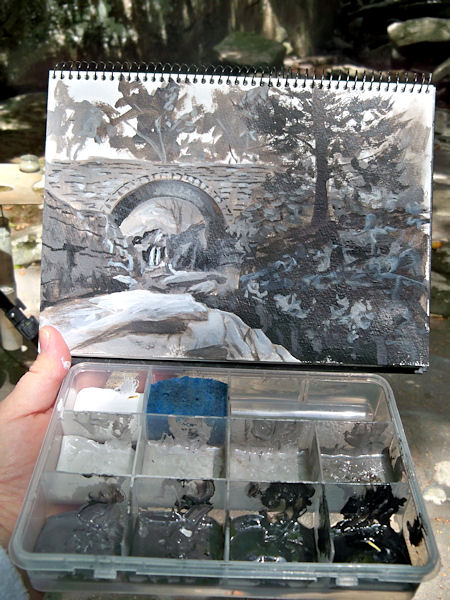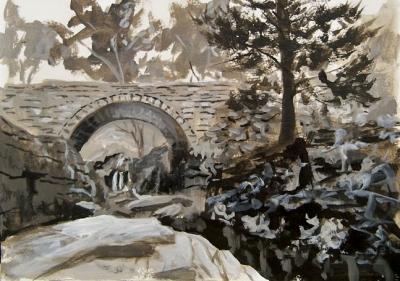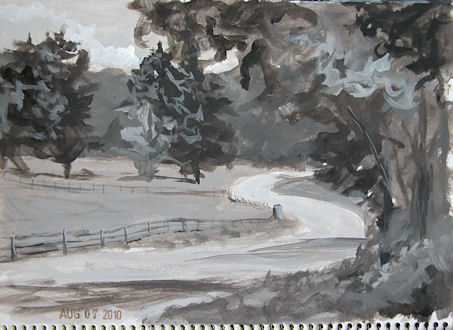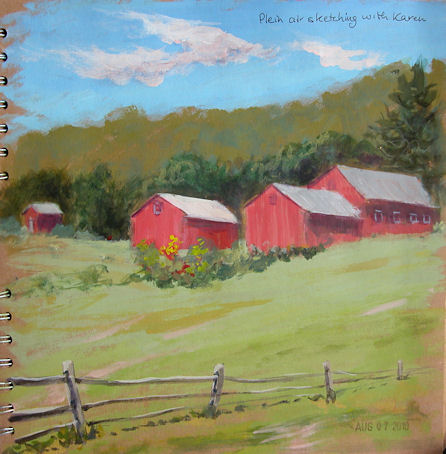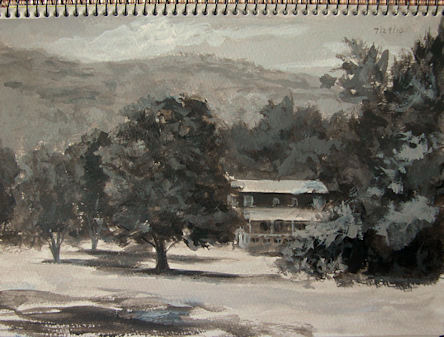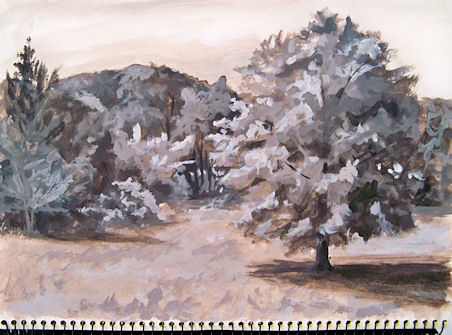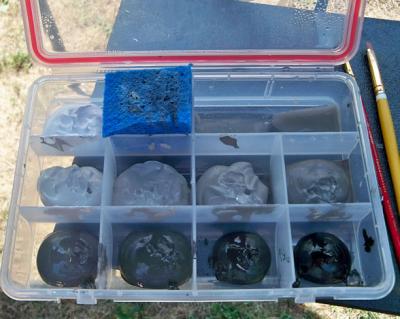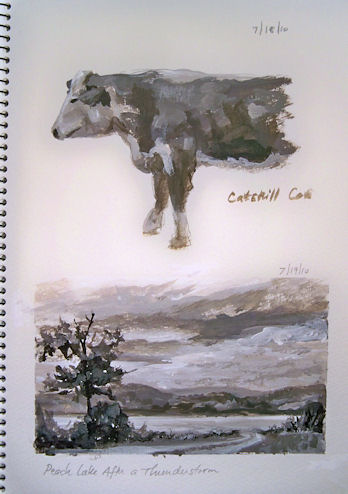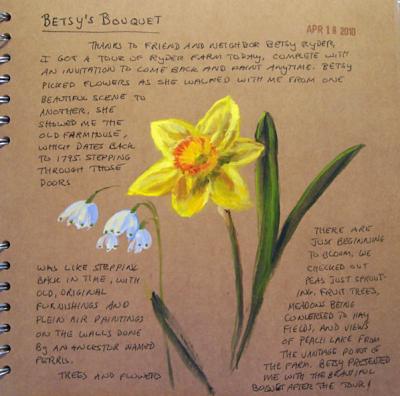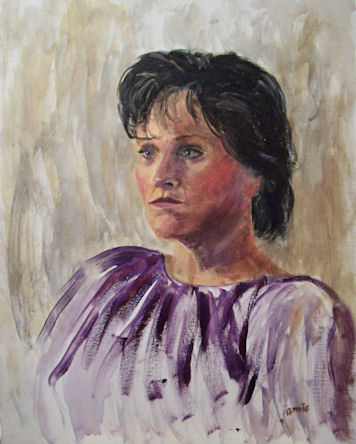To see Part I of this review,
click here. Each image in the post below can be clicked to enlarge it.
Since I was having difficulty getting the watercolor to take on the page prepared with a fairly heavy layer of acrylic (See the Part I link above), I wondered if the paper would hold up to using other grounds that might be more successful for my application. I thought perhaps adding Golden Absorbent Ground to my paint would help. This kind of experimentation can become a long, convoluted path to a solution, so I decided to attempt to find a more direct approach to my destination by calling Mike Townsend at Golden Paints tech support. I'm so glad I did that!
"Right thinking, wrong product!" Mike said. He suggested I try their Matte Medium mixed into the paint or over top of my prepared surface instead, explaining that it would give additional tooth for the watercolor to hold, while remaining transparent on my prepared pages.
I was delighted to hear that advice because
- I already have several bottles of it, and
- Golden Matte Medium happens to be one of my favorite products on the face of the earth.
When I first was advised to use it for something, I loved it so much that I started putting it on everything. I probably would have used it for a dessert topping if it were edible! I was more than happy to try it in my sketchbook.
I tried using it a few different ways. On the page below, I mixed Golden Iridescent Bright Gold Fluid Acrylic with water and Golden Matte Medium. I dried it with a hair dryer, and then the image was painted with watercolor and the writing done. The Alpha paper dried almost completely flat with the hair dryer, so painting on it was not a problem.

The additional tooth provided by the Matte Medium definitely allowed more pigment to go down on the page. This wasn't a great choice of things to paint to showcase that, but you can see that I was able to get plenty of red paint down on that little bottle, and the fountain pen still wrote just fine on the surface. However, Matte Medium is called that for a reason, and I lost the glossy sheen that I was so attracted to. The gold no longer shimmered through the watercolor, and it looked like I'd painted over a yellow page, not gold. (It's hard to see those kinds of differences in a photo, so you'll just have to take my word for it, or better yet, give it a try!)
I wanted to see better comparisons of watercolor on the paper with and without the Matte Medium coating. I painted the page below with Golden Fluid Acrylic Iridescent Pearl (a pretty substantial covering of it), dried it with a hair dryer, sponge painted the border, dried that, then applied Golden Matte Medium diluted about 4:1 with water (80% Matte Medium), and coated
only the right side of the page with it.
The first thing I noticed is that the iridescence is all but gone on the Matte Medium-coated right side, even though in a photo they both look the same. The right side pretty much just looks like just white paper, but the left side glistens.
I then painted watercolor samples on each side, using the same colors and same brushes, so I could assess the differences. It will definitely take some practice to work well on these surfaces, but as I worked down the pages, doing one color at a time on each page, then going to the next color, it was possible to get a much more even and complete coat of paint on the side with the Matte Medium. That's a good thing......sometimes. But I'd lost the iridescence in the process, so unless I was working on a base of colored paint, I may as well have painted on the white paper surface without any acrylic, and made it a lot easier for myself! This would be good to use over a colored acrylic ground though.
The left side, which had the iridescent glossy surface, did not take the watercolor paint as well for sure. However, the open areas where there is less paint allow the shimmer to show through the watercolor, and I get the beautiful glimmery background. That's a good thing too!
Doing this direct comparison helped me learn what I can expect using either a Matte-Medium coated or uncoated surface. Watercolor is unpredictable enough without adding more unknown variables to the process! If you want as much shimmer as possible, don't coat the surface. If you're not using iridescent paint, Matte Medium will help watercolor paint adhere to the surface.
But wait! Isn't this supposed to be a sketchbook review, not a discussion of paint products and process? So, why am I even calling this "Part II of Stillman and Birn Alpha Hardbound Sketchbook Testing and Review"? Well, I'm learning that a sketchbook that meets all your needs is, in a way, invisible. It's like painting on a canvas or linen that's prepared exactly the way you like it. You can then paint without thinking about your surface. There is enough to concentrate on with just painting! What I
haven't had to say is a testament to the non-issues I've had with this book. I haven't needed two extra hands to hold the book open while I work. I haven't had a wet binding fall apart on me. I haven't had pages pill and prevent me from writing, or tear out of the book. I haven't encountered extra layers of paint and medium being too much for the stitching to hold the pages together. As far as the Alpha hardbound sketchbook is concerned, I have been able to do everything I've wanted to do. Detailing these processes says everything about the book's capabilities and what it can handle. I haven't yet tried anything that it can't do.There are now over 20 two-page spreads of acrylic page preparations done in this book, with most of them already covered with additional mediums of one kind or another, and the book is holding up great.
Some folks wrote to me or posted questions that I thought would be worth including here. Feel free to email/post any additional questions you might have, and I'll include them in tomorrow's post --- hopefully with answers!
Q: Where can I find the Stillman & Birn sketchbooks?
A:
Here is a link to a page on their website that lists stores and online venues that carry their books.
Q: Did you have any bleed through to the following pages? I am just about ready for a new sketchbook and am thinking about the Alpha. I do pen and ink with watercolor washes.
A: I've never had bleed-through in this book with any of my ink/watercolor testing, which has been pretty extensive. I'm quite sure you'd be safe with the Alpha!
Q: What is the difference between the Noodler's Zhivago and Noodler's Sequoia ink that you've used in the
page of ink samples posted yesterday?
A: I can see that they look nearly identical in that image! They are both nice, fairly neutralized greens in wash. When writing with the Zhivago, the ink is so dark that it appears black. When used with water as a wash, the black lines wash very little, and the green washes a lot. So the effect is that it blossoms with color, yet leaves behind crisp lines. The Sequoia ink is a dark green, but not so dark that it ever looks black. The color washes a bit more, and it doesn't leave such edgy lines behind. Even though the wash colors might appear similar in the image, the effects of the two inks are actually quite different.
Q: It looks like Noodler's Bulletproof Black (
in that same image) washes and isn't so "bulletproof"! What's up with that?
A: The Noodler's Bulletproof inks vary in their water resistance depending on what paper you use. That Bulletproof Black bonds with the cellulose fibers of the paper, so it depends on how much fiber the ink reaches, sizing of the paper, thickness of the ink layer, etc. For more information on that and other black inks that are declared water resistant/waterproof,
you can check this post.
There will be another review installment tomorrow, when I'll discuss some alterations I made to the book, the designing of a journaling font for writing, more about the effects of Matte Medium, and page transparency.
To read Part III of this review,
click here.















